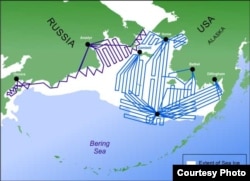Scientists from Russia and the United States are gearing up for an ambitious effort to count seals in the Bering Sea.
The goal of the U.S.-Russia Collaborative Ice Seal Survey is "to provide the first comprehensive estimates of abundance for ice-associated seals," according to the U.S. agency behind the effort.
There are four seal species found in the Bering Sea -- the ribbon, spotted, bearded, and ringed seals -- and all are heavily dependent on dwindling Arctic ice for their well-being.
So in addition to what the combined thermal imaging and high-resolution photos might say about the species themselves, their health and numbers could also say something about underlying climate and other environmental issues.
Says the National Marine Mammal Laboratory, which does field work for the U.S. National Oceanic and Atmospheric Administration (NOAA):
It's unclear how Russian authorities plan to use the data.
Not so for their U.S. counterparts, AP says:
Historically, the Bering Sea provided one of the most spectacular manmade extinctions in history in the form of the Steller's sea cow. That fat, slow-moving, and apparently trusting plant-eater was wiped out within a few decades of its discovery by European hunters.
But the Bering Sea has also been the backdrop for ground-breaking cooperation on marine mammals. A little more than a century ago, that sea was the subject of a four-party treaty between the United Kingdom, Japan, Russia, and the United States to ban the hunting of seals on the open sea. Dubbed the North Pacific Fur Seal Convention of 1911, that agreement led to other ecological successes.
The 1911 deal, the NOAA notes:
This new survey, which gets airborne this week, should include about 11,000 nautical miles and another 19,000 nautical miles of flightpath over Russian and U.S. waters, respectively.
The goal of the U.S.-Russia Collaborative Ice Seal Survey is "to provide the first comprehensive estimates of abundance for ice-associated seals," according to the U.S. agency behind the effort.
There are four seal species found in the Bering Sea -- the ribbon, spotted, bearded, and ringed seals -- and all are heavily dependent on dwindling Arctic ice for their well-being.
So in addition to what the combined thermal imaging and high-resolution photos might say about the species themselves, their health and numbers could also say something about underlying climate and other environmental issues.
Says the National Marine Mammal Laboratory, which does field work for the U.S. National Oceanic and Atmospheric Administration (NOAA):
Spring is the best time to survey because the seals concentrate within the Bering Sea pack ice and spend more time on the ice, where they can be seen and counted, while they have pups, breed and molt. The results of this study will contribute to the scientific understanding of these unique marine mammals and will be used to identify, evaluate and resolve conservation concerns as required by the Marine Mammal Protection Act. The results will also help to assess the risk posed by loss of sea-ice habitat that may occur due to ongoing and anticipated warming of the Arctic climate, a key concern addressed in status reviews that NOAA has conducted on all four species under the Endangered Species Act.
It's unclear how Russian authorities plan to use the data.
Not so for their U.S. counterparts, AP says:
Scientists will count ringed and bearded seals, which the National Oceanic and Atmospheric Administration has recommended for listing as threatened species due to climate warming.
The agency is reviewing a third ice-dependent species, the ribbon seal, and will count spotted seals, a species it rejected for listing three years ago.
The agency is reviewing a third ice-dependent species, the ribbon seal, and will count spotted seals, a species it rejected for listing three years ago.
Historically, the Bering Sea provided one of the most spectacular manmade extinctions in history in the form of the Steller's sea cow. That fat, slow-moving, and apparently trusting plant-eater was wiped out within a few decades of its discovery by European hunters.
But the Bering Sea has also been the backdrop for ground-breaking cooperation on marine mammals. A little more than a century ago, that sea was the subject of a four-party treaty between the United Kingdom, Japan, Russia, and the United States to ban the hunting of seals on the open sea. Dubbed the North Pacific Fur Seal Convention of 1911, that agreement led to other ecological successes.
The 1911 deal, the NOAA notes:
was the first international treaty to address the issue of wildlife conservation and represented "a major victory for the conservation of natural resources, a signal triumph of diplomacy…, and a landmark in the history of international cooperation."
This new survey, which gets airborne this week, should include about 11,000 nautical miles and another 19,000 nautical miles of flightpath over Russian and U.S. waters, respectively.





